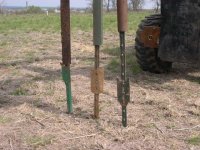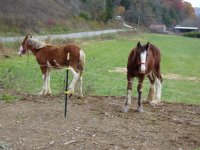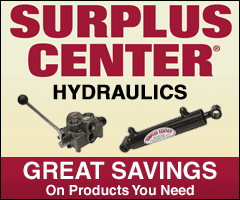Rory_Rhodes said:
How can I best utilize the FEL on my
L3130 or the bucket or forks on my skid steer to set the in straight and at a consistent depth. Okay, the depth should be a problem but straight (both plumb and in a straight line) would be a priority.
I'll share my experience setting T posts using the FEL on my NH TC25D. First, I marked every post with a depth line so I could see from the tractor how far the post was in the ground. Marking each post also helps you know if you hit rock. I also marked, using construction spray paint, the location for every post.
The process took 2 people. One to hold the T Post and one on the tractor. One person holds the T post until the bucket just touches the T post. Then they get way out of the way to watch and make sure the T post is going in straight. I tried adding weight to the FEL, but if I hit rock, nothing helped. I also placed a hand T Post driver on top of the post to increase the surface area the bucket contacted.
If you hit rock, the post will either stop going in or veer off plumb. In such situations, several things can happen.
1. Post keeps going in, at a slight angle.
2. Post slips off the FEL bucket, which can be very dangerous.
3. The front of the tractor comes off the ground.
With Items 2 and 3, you have to move the post a little (left/right or front/back) and start all over.
If you have rocky soil, this will be a long, frustrating task.
I used this method for about 20 T posts around our small riding ring. I bought a post driver to fence in 3 acres.
You'll also want to cap each T Post for safety reasons.
For your 4,000' of 4 board fence, I'd definitely recommend a post driver. It turns a multi-step job using a post hole digger into a one step job. A post driver can also set T Posts.
EDIT:
WTA's post reminded me I used a similar technique for marking the locations for the posts. I set the corner posts first, making sure to keep them far enough away from a tree line, creek, etc. to allow enough room to get a tractor and mower on the outside of the fence to keep the grass mowed.
I then pulled a string between the corner posts and used a 7.5 foot 2" x 4" to mark the post locations. No need for a tape measure. I used 7.5 feet between posts (4" x 4" x 8' PT) because I thought I might eventually want to install a board fence. No way. Way too costly and way too much maintenance. If I hadn't allowed for this, I would have gone at least 16 feet between posts.
If a post went in crooked, within a few degrees of plumb, I was happy. Most went in straight and plumb.
The post driver also allowed me to do all the work by myself. No need for assistance. The process was;
1. Set all corner posts first. For the corner posts, I did use a phd and concreted them in.
2. String line between posts
3. Mark post locations
4. Fill FEL with posts
5. Drive to each mark and drop off post
6. Start driving posts. I also marked all posts ahead of time, 3' up from the bottom so I knew when to stop driving them in. Corner posts were set 4 feet deep.
I broke the job into manageable chunks and set goals for the morning, afternoon and evening. Otherwise it's easy to get overwhelmed when you look at all the posts that need set. I never laid out more posts than I could set in a day since I didn't want them laying on the ground getting wet and possibly twisting. I kept my stockpile of posts on a pallet, off the ground and under a tarp until I needed them.


